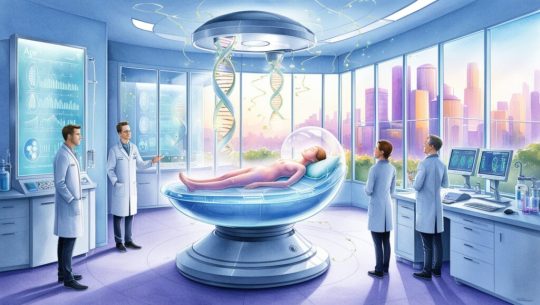#BiologicalProcesses
Explore tagged Tumblr posts
Text
The Power of Protein Building Blocks of Health
The Power of Protein Building Blocks of Health health of the human body An important macronutrient for the growth, repair, and general health of the human body is protein. Proteins are the building blocks of life; they are made up of smaller units called amino acids, which are essential for many body processes. Knowing the importance and strength of protein reveals its many functions in…

View On WordPress
#AminoAcids#BiologicalProcesses#CellularFunction#Enzymes#HealthBenefits#HealthyDiet#MuscleDevelopment#Proteins#TissueRepair#nutrition#pregnancy nutrition#Protein Sources#Public Health#Relaxation Techniques
0 notes
Text
Why Do Cells Age and Die 2025

Why Do Cells Age and Die 2025
Cells—the basic units of life—do not live forever. Like all living things, they have a natural life cycle: they grow, perform functions, divide, and eventually die. But why does this happen? Why can’t a cell just keep going endlessly? In 2025, thanks to major breakthroughs in cell biology, genetics, and aging science, we now have a clearer understanding of the cellular aging and death process than ever before. Let’s explore what makes cells age, why they eventually die, and how this ties into larger systems like aging, disease, and life expectancy. Book-Level Explanation Cells age and die due to both internal mechanisms and external factors. There are two main biological processes that drive this: 1. Cellular Senescence Cellular senescence refers to a permanent state where cells stop dividing but remain metabolically active. It’s usually triggered by DNA damage, oxidative stress, or the shortening of telomeres (protective ends of chromosomes). Senescent cells don’t die immediately, but they lose their ability to function normally and may release inflammatory signals that can harm neighboring cells. 2. Programmed Cell Death (Apoptosis) Apoptosis is a highly regulated and natural form of cell death. It plays a vital role in development, immune response, and tissue homeostasis. When a cell is damaged beyond repair, or if it’s no longer needed (such as after an infection is cleared), it undergoes apoptosis to safely dismantle and remove itself. Other factors also play key roles: - Telomere shortening: Telomeres act like protective caps at the end of chromosomes. With every division, they get shorter. When they become too short, the cell can no longer divide. - DNA damage: Radiation, toxins, and errors in replication can damage DNA. If the damage is too extensive, it can trigger senescence or apoptosis. - Mitochondrial dysfunction: As cells age, mitochondria (energy-producing organelles) become less efficient and produce more reactive oxygen species (ROS), which damage cellular components. These mechanisms are essential for the survival of organisms. They prevent the spread of damaged or potentially cancerous cells and help renew tissues. Easy Explanation Think of a cell like a little worker in your body. It has a job to do—maybe it builds things, cleans waste, or helps protect you from germs. But even the hardest worker gets tired over time. That’s basically what happens with cells. Every time a cell divides, it makes a copy of itself. But with each copy, its "shoelace tips" (called telomeres) get shorter. When those tips are too worn out, the cell can’t divide anymore. It’s like trying to tie your shoes with frayed laces—it just doesn’t work. Some cells also get sick from stress, like too much sun, pollution, or chemicals. When they’re damaged beyond repair, they self-destruct through a process called apoptosis. This is the body’s way of recycling broken or dangerous cells so new, healthy ones can take their place. Sometimes, a cell doesn’t die right away but goes into “retirement” mode. It’s still alive but not really working anymore. These retired cells are called senescent cells. If too many build up, they can actually cause inflammation and problems in your body. So, cells age and die to keep your body clean, efficient, and healthy. If they didn’t, damaged cells could cause serious issues like cancer.




Why This Matters in 2025 In the last few years, scientists have made major progress in understanding and even reversing some parts of the aging process. Some highlights: - Researchers have identified compounds called senolytics that can selectively remove senescent cells from tissues. Early trials show these might help reduce age-related inflammation and improve health span. - CRISPR and other gene-editing tools are being used to investigate telomere extension and DNA repair. - Studies in model organisms have shown that controlling mitochondrial health can slow down cellular aging. There’s even speculation that cellular rejuvenation techniques could one day delay aging and age-related diseases in humans. Real-World Impact The way cells age and die affects everything from your skin wrinkling to the development of Alzheimer’s, cancer, and heart disease. It also plays a role in immune system decline, making older adults more vulnerable to infections. By better understanding this process, researchers can: - Develop anti-aging therapies - Create more effective cancer treatments - Improve regenerative medicine (e.g., using stem cells) - Enhance organ transplant outcomes This field is central to the future of personalized and preventative medicine.
Conclusion
Cells age and die because it’s part of nature’s way of maintaining balance. While it might seem like a flaw, it’s actually a protective system that helps your body stay healthy. In 2025, scientists are closer than ever to unraveling the secrets of cellular aging—and perhaps even learning how to slow it down. External Link for Further Reading: Learn more about cell aging and programmed death on Wikipedia: https://en.wikipedia.org/wiki/Cell_senescence Our Blogs You Might Like What If Human Consciousness Could Be Uploaded Into Light 2025 https://edgythoughts.com/what-if-human-consciousness-could-be-uploaded-into-light-2025 How Do Gut Bacteria Shape the Brain 2025 https://edgythoughts.com/how-do-gut-bacteria-shape-the-brain-2025 Disclaimer: The easy explanation is designed to help readers of all backgrounds understand complex scientific concepts. If you're a student, always follow your school's guidelines and refer to your textbooks or academic materials when preparing for exams or assignments. We're here to support your learning—not replace your curriculum. Read the full article
#20250101t0000000000000#20250420t0000000000000#2025httpsedgythoughtscomhowdogutbacteriashapethebrain2025disclaimerthe#2025httpsedgythoughtscomwhatifhumanconsciousnesscouldbeuploadedintolight2025how#ageing#agingassociateddiseases#alzheimer'sdisease#apoptosis#bacteria#biologicallifecycle#biologicalprocess#biology#cancer#cancertreatment#cardiovasculardisease#cell(biology)#celldivision#cellsignaling#cellularcomponent#cellularsenescence#chemicalsubstance#chromosome#consciousness#crispr#curriculum#disease#dnadamagenaturallyoccurring#dnarepair#dnareplication#explanation
0 notes
Text

Solvation
Solvation is the process by which solvent molecules surround and interact with solute particles, facilitating dissolution and stabilization. It plays a critical role in chemical reactions, ion transport, biological processes, and materials science. Solvation dynamics help understand solute-solvent interactions, thermodynamics, and kinetics at molecular levels. Advanced computational techniques like molecular dynamics simulations and quantum chemistry are often used to study solvation phenomena, including hydration shells, ionic solvation, and solvation energy.
International Chemistry Scientist Awards
🔔 Subscribe for more insights on chemistry innovations!
Website: chemistryscientists.org
Contact us: [email protected]
Nominate now: https://chemistryscientists.org/award-nomination/?ecategory=Awards&rcategory=Awardee
#sciencefather#researchawards#Professor,#Lecturer,#Scientist,#Scholar,#Researcher #Solvation #Chemistry #MolecularInteractions #SoluteSolvent #Dissolution #ChemicalReactions #Hydration #IonicSolvation #MolecularDynamics #QuantumChemistry #SolvationEnergy #MaterialScience #Thermodynamics #BiologicalProcesses #SolutionChemistry #SolvationDynamics
👉 Don’t forget to like, share, and subscribe for more exciting content!
Get Connected Here: =============
Blogger : https://www.blogger.com/blog/post/edit/6961521080043227535/467226973388921229
Twitter : https://x.com/chemistryS79687
Pinterest : https://in.pinterest.com/chemistryaward/
Instagram: https://www.instagram.com/alishaaishu01/
Youtube : https://www.youtube.com/channel/UCAD_pDvz3ZHqv_3hf-N0taQ
Blaze
0 notes
0 notes
Text
What If We Could Live Forever Using Genetic Engineering 2025

What If We Could Live Forever Using Genetic Engineering 2025
The dream of immortality is as old as human civilization itself. From ancient myths about the Fountain of Youth to science fiction tales of digital consciousness, the idea of living forever has fascinated thinkers, scientists, and everyday people alike. But in 2025, we're closer than ever to turning that fantasy into a scientific possibility—through the lens of genetic engineering. What if we could reprogram our biology, fix aging at the molecular level, and extend human life indefinitely? Let’s dive into the science, the speculation, and the staggering implications of this futuristic concept.
The Science of Aging: Can It Be Reversed?
Aging is not just the passage of time—it's a biological process. At its core, aging results from cellular damage, DNA mutations, oxidative stress, telomere shortening, and other factors that gradually degrade our body’s function. But what if we could fix those issues? That’s where genetic engineering comes in. Genetic Tools in 2025 In recent years, powerful tools like CRISPR-Cas9, base editing, and epigenetic reprogramming have revolutionized genetic science. These technologies allow scientists to: - Edit faulty genes - Remove mutations - Reset epigenetic markers associated with aging - Regrow tissues and organs from stem cells Researchers are already experimenting with genes like FOXO3, SIRT1, and TP53—genes known to influence longevity. In mice and worms, tweaking these genes has extended lifespan by up to 50%. While we're still in the early stages with humans, the potential is enormous.




Pathways to Immortality Through Genetic Engineering
If we assume continued breakthroughs in biotech, here are several pathways that might lead us to biological immortality: 1. Telomere Extension Telomeres are protective caps on the ends of our chromosomes that shorten each time a cell divides. Once they become too short, the cell stops functioning properly. Genetic therapies could reactivate the enzyme telomerase, which rebuilds telomeres and slows aging. Example: In 2024, researchers at a major biotech firm used telomerase activation in mice to extend their healthy lifespan by 30% without increasing cancer risk. 2. Senescent Cell Removal As we age, our bodies accumulate senescent cells—cells that no longer divide but don’t die. These cells secrete harmful chemicals that damage nearby tissue. Genetic engineering might allow us to target and eliminate these cells, reducing inflammation and restoring tissue function. 3. DNA Repair Enhancement One of the biggest causes of aging is the accumulation of DNA damage. Using gene editing, scientists could enhance natural DNA repair mechanisms, making cells more resilient and less prone to mutation. 4. Epigenetic Reprogramming This technique involves resetting a cell's “biological clock” by modifying gene expression, not the DNA itself. Some scientists believe we can return cells to a more youthful state, effectively reversing aspects of aging.
Ethical and Social Implications
Living forever might sound incredible, but it comes with massive ethical baggage. Here are some questions we’d have to grapple with: - Who gets access to life-extending treatments? Just the wealthy? - What happens to population growth, resource distribution, and employment? - Would immortality change our sense of purpose, risk, and identity? - Could living forever dull the meaning of life? There’s also the risk of unintended consequences. What if reactivating certain genes to extend life also increases the risk of cancer? Or creates unforeseen changes in behavior or cognition?
Could This Actually Happen?
In 2025, we're not immortal yet. However, longevity research is booming, and life-extension breakthroughs are happening faster than many anticipated. Companies like Calico (Google’s longevity arm), Altos Labs, and numerous university labs are pushing boundaries in age reversal. Clinical trials involving gene therapies for specific aging-related diseases—like macular degeneration, Alzheimer’s, and cardiovascular disease—are already underway. Experts believe that within the next 10 to 20 years, we might not achieve full immortality, but we could dramatically extend the human lifespan and quality of life.
A Future Without Death?
If genetic engineering could one day eliminate aging and disease, we might see an entirely new kind of human society: - People living for centuries - Shifting family and social structures - Long-term careers and infinite learning - New philosophical questions about existence But we’d also face major challenges: environmental strain, overpopulation, and existential boredom. It’s one thing to imagine a world without death—living in it would be something entirely different.
Conclusion
The idea of living forever using genetic engineering may seem like science fiction, but in 2025, it’s becoming more of a scientific possibility than ever before. By manipulating the very code of life, we might one day control aging, conquer disease, and rewrite what it means to be human. But with this power comes the responsibility to consider the moral, social, and ecological impact of eternal life. We must ask: just because we can live forever—should we? — For a deeper look into genetic engineering and aging, check out: https://en.wikipedia.org/wiki/Gene_therapy — 🧬 Explore more of our speculative science blogs: What If Human Consciousness Could Be Uploaded Into Light 2025 https://edgythoughts.com/what-if-human-consciousness-could-be-uploaded-into-light-2025 What If Dreams Could Be Recorded and Played Back 2025 https://edgythoughts.com/what-if-dreams-could-be-recorded-and-played-back-2025 Read the full article
#1#10#2#20#2024-01-01t00:00:00.000+00:00#2025-01-01t00:00:00.000+00:00#2025https://edgythoughts.com/what-if-dreams-could-be-recorded-and-played-back-2025#2025https://edgythoughts.com/what-if-human-consciousness-could-be-uploaded-into-light-2025#3#30#4#50#ageing#altoslabs#alzheimer'sdisease#baggage#behavior#biologicalimmortality#biologicalprocess#biology#biotechnology#blog#boredom#calico(company)#cancer#cardiovasculardisease#cell(biology)#cellularsenescence#chemicalsubstance#chromosome
0 notes